
Graffiti is art that is written, painted or drawn on a wall or other surface, usually without permission and within public view. Graffiti ranges from simple written words to elaborate wall paintings, and has existed since ancient times, with examples dating back to ancient Egypt, ancient Greece, and the Roman Empire.
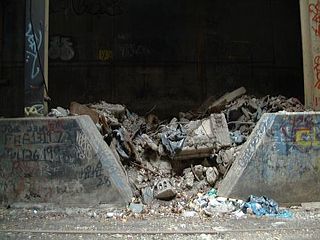
In the United States, the term mole people is sometimes used to describe homeless people living under large cities in abandoned subway, railroad, flood, sewage tunnels, and heating shafts.

Dark Days is an American documentary film directed, produced, and photographed by the English documentarian Marc Singer that was completed and released in 2000. Shot during the mid-1990s, it follows a group of people who lived in the Freedom Tunnel section of the Amtrak system at the time. DJ Shadow created new music for the documentary and also let Singer use some of his preexisting songs.

The Henry Hudson Parkway is a 10.95-mile (17.62 km) controlled-access parkway in New York City. The southern terminus is in Manhattan at 72nd Street, where the parkway continues south as the West Side Highway. It is often erroneously referred to as the West Side Highway throughout its entire course in Manhattan. The northern terminus is at the Bronx–Westchester county boundary, where it continues north as the Saw Mill River Parkway. All but the northernmost mile of the road is co-signed as New York State Route 9A (NY 9A). In addition, the entirety of the parkway is designated New York State Route 907V (NY 907V), an unsigned reference route.

The West Side Line, also called the West Side Freight Line, is a railroad line on the west side of the New York City borough of Manhattan. North of Penn Station, from 34th Street, the line is used by Amtrak passenger service heading north via Albany to Toronto; Montreal; Niagara Falls and Buffalo, New York; Burlington, Vermont; and Chicago. South of Penn Station, a 1.45-mile (2.33 km) elevated section of the line, abandoned since 1980, has been transformed into an elevated park called the High Line. The south section of the park from Gansevoort Street to 20th Street opened in 2009 and the second section up to 30th Street opened in 2011, while the final section to 34th Street opened in 2014.

Street art is visual art created in public locations for public visibility. It has been associated with the terms "independent art", "post-graffiti", "neo-graffiti" and guerrilla art.

Lady Pink, born Sandra Fabara (1964), is an Ecuadorian-American graffiti and mural artist.
Zoo York is a style and social philosophy inspired by the New York City graffiti art subculture of the 1970s. Its name originates from a subway tunnel running underneath the area of the Central Park Zoo. This tunnel, called the Zoo York Tunnel, or simply "Zoo York," was a haunt of very early "old school" graffiti writers who hung out with the hippies around the Central Park Bandshell in the late 1960s and 1970s.
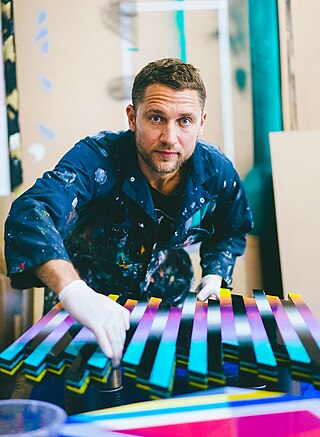
Tavar Zawacki formerly known as 'ABOVE' is an American abstract artist living and working between Berlin, Germany and Lisbon, Portugal. For twenty years (1996–2016) Tavar Zawacki created and signed all of his artworks with his street artist pseudonym, 'ABOVE'. Tavar was born and raised in California until the age of 19, at which time, Zawacki bought a one-way flight from California to Paris, France, bringing with him a backpack full of art supplies, all the money in his bank account (US$1,500), and a 'rise above your fears' approach to starting his art career. Starting in Paris in 2000, Tavar transitioned from painting traditional letter style graffiti of A-B-O-V-E, to his 'Above arrow' icon that represented his optimistic mentality to 'rise above fears, challenges, and anything holding you back from your goals.' During a 20-year period, the artworks of ABOVE could be seen in over 80 cities spanning 35 countries around the world.

Since the 1980s, the area surrounding the Sydney inner west suburb of Newtown, Australia, including the suburbs of Newtown, Enmore, Erskineville, Camperdown and St Peters, has been known for its wide range of prominent graffiti and street art on walls. The public visual art in the Newtown area consists of a variety of styles and methods of execution, including large-scale painted murals, hand-painted political slogans, hand-painted figurative designs, spray painted semi-abstract designs "tags"), and other stylistic developments such as stencil art and street poster art, "Yarn bombing", and sculptural items cast from plaster and other materials.

Pomona–Downtown station, is a train station in Pomona, California, United States. It is primarily served by Metrolink’s Riverside Line commuter rail service, which runs between Los Angeles Union Station in the west and Riverside–Downtown station in the east. It is also less frequently serviced by two of Amtrak's long-distance inter-city rail services, the Sunset Limited, which runs between Union Station and New Orleans, Louisiana, and the Texas Eagle, which runs between Union Station and Chicago, Illinois, via Texas. It is owned and operated by the city of Pomona.
Chris Pape is an American painter and graffiti artist. He started tagging subway tunnels and subway cars in 1974 as "Gen II" before adopting the tag "Freedom". Pape is best known for his numerous paintings in the eponymous Freedom Tunnel, an Amtrak tunnel running underneath Manhattan's Riverside Park. Prominent paintings in the Freedom Tunnel attributed to Pape include his "self-portrait", featuring a male torso with a spray-can head, and "There's No Way Like the American Way", a parody of Coca-Cola advertising and tribute to the evicted homeless of the tunnel. Another theme of Freedom's work is black and silver recreations of classical art, including a reinterpretation of the Venus de Milo and a full train car recreation of the iconic hands from Michelangelo's Sistine Chapel. Chris Pape also was one of the first documentarians to cover the mole people, homeless living underground in the Freedom Tunnel.
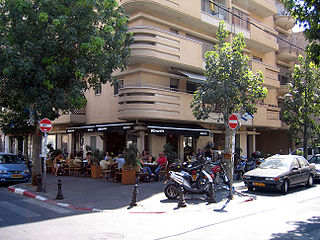
Florentin is a neighborhood in the southern part of Tel Aviv, Israel, named for Solomon Florentin, a Greek Jew who purchased the land in the late 1920s. Development of the area was spurred by its proximity to the Jaffa–Jerusalem railway.

Stephen J. Powers is an American contemporary artist and muralist. He is also known by the name ESPO, and Steve Powers. He lives in New York City.
Voices in the Tunnels is a 2008 documentary directed by Vic David, a New York City filmmaker and a graduate from New York University. It explores the lives of people who lived in the New York City Subway tunnels.
RISK, also known as RISKY, is a Los Angeles–based graffiti writer and contemporary artist often credited as a founder of the West Coast graffiti scene. In the 1980s, he was one of the first graffiti writers in Southern California to paint freight trains, and he pioneered writing on "heavens", or freeway overpasses. He took his graffiti into the gallery with the launch of the Third Rail series of art shows, and later created a line of graffiti-inspired clothing. In 2017, RISK was knighted by the Medici Family.

Graffiti in New York City has had a substantial local, national, and international influence.
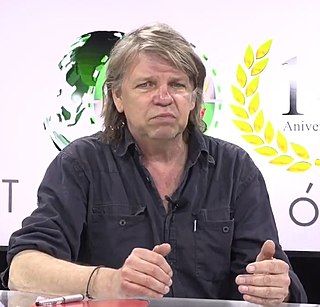
Teun Voeten is a Dutch photojournalist and cultural anthropologist specializing in war and conflicts. In 1996 he published the book Tunnelmensen about homeless people living in an old railroad tunnel in Manhattan. He also wrote books on the war in Sierra Leone and made a photo book on the drug violence in Mexico, on which subject he wrote a PhD thesis at Leiden University.
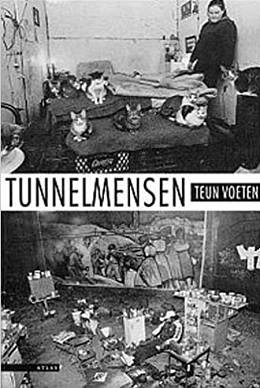
Tunnel People is an anthropological-journalistic account describing an underground homeless community in New York City. It is written by war photographer and anthropologist Teun Voeten and was initially published in his native Dutch in 1996, and a revised English version was published by the Oakland-based independent publishing house PM Press in 2010.
Margaret Morton was an American photographer, author, and professor of visual arts. She was a School of Art Professor at Cooper Union. For several decades beginning in the late 1980s, Morton's body of work largely depicted communities of homeless people in New York City. She published a number of photo collections in books, usually supplemented by detailed interviews with the photos' subjects. Her work was noted for depicting human stories within communities that were both highly structured and quite temporary, often shortly before their forcible destruction by New York Cities authorities. Her success in documenting poverty in New York City has been compared to the work of Jacob Riis.



















